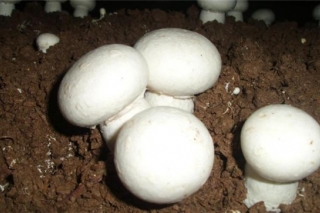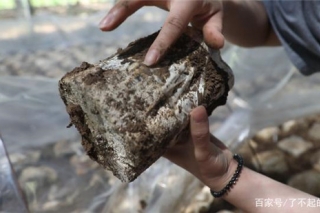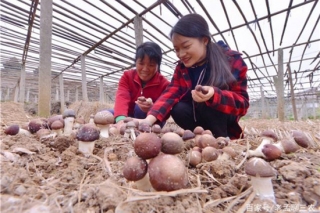TI: Mating competence and biological species within the subgenus Coremiopleurotus.
AU: Zervakis-GI
SO: Mycologia. 1998, 90: 6, 1063-1074; 45 ref.
LA: English
AB: Forty-eight synnematous Pleurotus strains from various parts of the world originally assigned to P. cystidiosus, P. abalonus, P. smithii, P. purpureo-olivaceus and P. australis were studied to determine the number of incompatibility groups, delimit morphologically similar taxa, establish genetic relationships, and identify speciation processes in geographically confined populations. The subgenus Coremiopleurotus appeared to be composed of 4 biological species: P. cystidiosus, P. smithii, P. purpureo-olivaceus and P. australis. The former encompasses a very widely-spread population, which presents varying degrees of intercompatibility and shows an allopatric speciation mode. Pleurotus abalonus actually represents a subspecies of P. cystidiosus, which includes Asiatic strains with a recognizable phenotype and a limited ability to interbreed with other synnematoid Pleurotus isolates of distant geographic origin. Pleurotus smithii is restricted to Latin America, and although it is morphologically similar to P. cystidiosus, no successful matings were observed in the crosses performed among them. The last 2 species are confined to Australasia and demonstrate distinct micromorphological and physiological characters (both for the teleomorph and the anamorph stage). Pleurotus purpureo-olivaceus showed complete intersterility versus strains from other continents, whereas certain isolates of P. australis were partially intercompatible in vitro with strains from different regions. Pleurotus gemmellarii is a synonym of P. cystidiosus or P. cystidiosus subsp. abalonus.
PT: Journal-article
AN: 991000838
TI: Genetic variability and systematics of eleven Pleurotus species based on isozyme analysis.
AU: Zervakis-G; Sourdis-J; Balis-C
SO: Mycological-Research. 1994, 98: 3, 329-341; 55 ref.
LA: English
AB: Eleven enzyme activities were used to study the intraspecific diversity and interspecific relatedness of 11 Pleurotus species: P. abalonus, P. columbinus, P. cornucopiae, P. cystidiosus, P. dryinus, P. eryngii, P. flabellatus, P. ostreatus, P. pulmonarius, P. sajor-caju, and P. sapidus. In addition, the zymograms of their homokaryotic progenies were evaluated to determine the number of genes and alleles encoding them. Among the 18 loci detected, three coded for peptidase A, two for glucose-6-phosphate dehydrogenase, leucine [cytosol] aminopeptidase, malate dehydrogenase, peptidase C and phosphoglucomutase, and one for acid phosphatase, hexokinase, isocitrate dehydrogenase, phosphogluconate dehydrogenase and hexose phosphate isomerase. Based on electrophoretic patterns, the 77 wild Pleurotus dikaryons were divided into 51 genotypic classes. The higher intraspecific genetic variation was demonstrated by P. cystidiosus and P. eryngii, while P. cornucopiae, P. dryinus and P. sajor-caju appeared to be the least diverse species examined. Furthermore, with the aid of numerical analysis, valid species such as P. cornucopiae, P. dryinus, P. eryngii and P. flabellatus were clearly distinguished. Among the rest of the taxa studied, the derived dendrograms permitted delimitation between P. abalonus-P. cystidiosus and P. columbinus-P. ostreatus, although the former members of these two pairs were previously considered as varieties. On the other hand, P. pulmonarius and P. sajor-caju formed a tight cluster indicative of a certain genetic affinity, which questions their original designation as distinct species. As regards P. sapidus, it presented a slightly higher proximity to the P. pulmonarius-P. sajor-caju complex than to P. ostreatus. Finally, the phylogenetic implications from the findings of this work are discussed.
PT: Journal-article
AN: 951603348
TI: Genetic variability and systematics of eleven Pleurotus species based on isozyme analysis.
AU: Zervakis-G; Sourdis-J; Balis-C
SO: Mycological-Research. 1994, 98: 3, 329-341; 55 ref.
LA: English
AB: Eleven enzyme activities were used to study the intraspecific diversity and interspecific relatedness of 11 Pleurotus species; P. abalonus, P. columbinus, P. cornucopiae, P. cystidiosus, P. dryinus, P. eryngii, P. flabellatus, P. ostreatus, P. pulmonarius, P. sajor-caju, and P. sapidus. In addition, the zymograms of their homokaryotic progenies were evaluated to determine the number of genes and alleles encoding them. Among the 18 loci detected, three coded for peptidase A, two for glucose-6-phosphate dehydrogenase, leucine [cytosol] aminopeptidase, malate dehydrogenase, peptidase C and phosphoglucomutase, and one for acid phosphatase, hexokinase, isocitrate dehydrogenase, phosphogluconate dehydrogenase and hexose phosphate isomerase. Based on electrophoretic patterns, the 77 wild Pleurotus dikaryons were divided into 51 genotypic classes. The higher intraspecific genetic variation was demonstrated by P. cystidiosus and P. eryngii, while P. cornucopiae, P. dryinus and P. sajor-caju appeared to be the least diverse species examined. Furthermore, with the aid of numerical analysis, valid species such as P. cornucopiae, P. dryinus, P. eryngii and P. flabellatus were clearly distinguished. Among the rest of the taxa studied, the derived dendrograms permitted delimitation between P. abalonus-P. cystidiosus and P. columbinus-P. ostreatus, although the former members of these two pairs were previously considered as varieties. On the other hand, P. pulmonarius and P. sajor-caju formed a tight cluster indicative of a certain genetic affinity, which questions their original designation as distinct species. As regards P. sapidus, it presented a slightly higher proximity to the P. pulmonarius-P. sajor-caju complex than to P. ostreatus. Finally, the phylogenetic implications from the findings of this work are discussed.
PT: Journal-article
AN: 951603348











